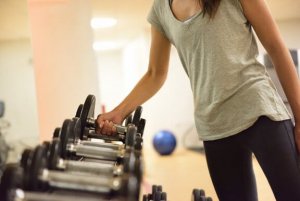Dumbbell Shrugs: how to do them correctly

Dumbbell shrugs are one of the best exercises to work the upper part of your body. In fact, this exercise is about making movements that isolate the work in the trapezius, especially the upper part. In this article, we’ll teach you how to do them correctly.
Dumbbell shrugs are probably one of the most popular exercises that weight-training athletes use to work their upper trapezius. And, it’s important to train these muscles to support the work in carrying heavy objects when you’re walking or standing up holding dumbbells or gym bars.
Similarly, you can work out the muscles you need in most sports or daily activities where you use the upper part of your body. This allows you to work the muscles that stabilize your shoulders and strengthen the neck.
However, the most common mistake occurs when you’re lifting too much weight while doing the shrugs. Although it’s an exercise that allows you to lift a heavy load, you must do it with the right technique.
Beyond this, you shouldn’t worry, because the movement you do is very simple. Next up, we’ll tell you the right way to do them.
How to do dumbbell shrugs
The movement starts by putting the dumbbells on the sides of your thighs, extending your arms and looking straight ahead. This helps you to avoid injuries in your neck or any type of contracture. Then, make sure you keep your abs squeezed in and your back straight.
For your posture, stand with your feet shoulder-width apart and with both dumbbells in your hands, at the sides of your body. Next, raise your shoulders as high as you can, keeping your arms straight. Squeeze your muscles in the high position, before returning to the starting position.
Don’t swing the dumbbells during the exercise; also, tighten your muscles to the maximum in the last part of the exercise. Remember: your arms must stay relaxed during the workout.

If you don’t have dumbbells, we recommend using a straight bar. However, this way the movement is less natural and harder to do because the bar rubs the front part of your thighs.
You also shouldn’t lift your head during each repetition. This movement that we usually unconsciously perform during the shoulder shrug may cause neck and back pain after training.
Tips to keep in mind
Dumbbell shrugs are usually performed standing up and with the legs apart. However, there are other things to keep in mind when you’re doing this exercise. These are some suggestions that you should take into consideration:
- Remember to stretch your shoulders before and after working to minimize the risk of injuries.
- Raise your shoulders as high as you can, to shorten and reduce the upper part of your trapezius.
- Do a perfectly vertical movement, because you should only move your shoulders, not your elbows.
- Keep your arms to the sides and your shoulders back. Focus on the position of your arms and be careful that the dumbbells aren’t in front of you.
- Avoid heavy loads; they make shrugs more complicated to do and increase the risk of injury.
- Keep your head straight when you do the repetitions. Do the exercise without any violent shaking that may result in injury. As we said before, use a straight bar or two dumbbells.
- Inhale while shrugging your shoulders, and exhale while lowering them, to go return to the starting position.

Always control your technique
Finally, we remind you that the popularity of dumbbell shrugs is because of its easy execution for all types of athletes, in addition to all the variants that this exercise has for you.
However, even though it’s a simple exercise, you must have the right posture, being careful not to force your back, shoulders or head. As we mentioned, the loads tend to be heavy, so you have to pay attention to the technique. To quickly improve and avoid making mistakes, don’t forget to ask a personal trainer for help!
Dumbbell shrugs are one of the best exercises to work the upper part of your body. In fact, this exercise is about making movements that isolate the work in the trapezius, especially the upper part. In this article, we’ll teach you how to do them correctly.
Dumbbell shrugs are probably one of the most popular exercises that weight-training athletes use to work their upper trapezius. And, it’s important to train these muscles to support the work in carrying heavy objects when you’re walking or standing up holding dumbbells or gym bars.
Similarly, you can work out the muscles you need in most sports or daily activities where you use the upper part of your body. This allows you to work the muscles that stabilize your shoulders and strengthen the neck.
However, the most common mistake occurs when you’re lifting too much weight while doing the shrugs. Although it’s an exercise that allows you to lift a heavy load, you must do it with the right technique.
Beyond this, you shouldn’t worry, because the movement you do is very simple. Next up, we’ll tell you the right way to do them.
How to do dumbbell shrugs
The movement starts by putting the dumbbells on the sides of your thighs, extending your arms and looking straight ahead. This helps you to avoid injuries in your neck or any type of contracture. Then, make sure you keep your abs squeezed in and your back straight.
For your posture, stand with your feet shoulder-width apart and with both dumbbells in your hands, at the sides of your body. Next, raise your shoulders as high as you can, keeping your arms straight. Squeeze your muscles in the high position, before returning to the starting position.
Don’t swing the dumbbells during the exercise; also, tighten your muscles to the maximum in the last part of the exercise. Remember: your arms must stay relaxed during the workout.

If you don’t have dumbbells, we recommend using a straight bar. However, this way the movement is less natural and harder to do because the bar rubs the front part of your thighs.
You also shouldn’t lift your head during each repetition. This movement that we usually unconsciously perform during the shoulder shrug may cause neck and back pain after training.
Tips to keep in mind
Dumbbell shrugs are usually performed standing up and with the legs apart. However, there are other things to keep in mind when you’re doing this exercise. These are some suggestions that you should take into consideration:
- Remember to stretch your shoulders before and after working to minimize the risk of injuries.
- Raise your shoulders as high as you can, to shorten and reduce the upper part of your trapezius.
- Do a perfectly vertical movement, because you should only move your shoulders, not your elbows.
- Keep your arms to the sides and your shoulders back. Focus on the position of your arms and be careful that the dumbbells aren’t in front of you.
- Avoid heavy loads; they make shrugs more complicated to do and increase the risk of injury.
- Keep your head straight when you do the repetitions. Do the exercise without any violent shaking that may result in injury. As we said before, use a straight bar or two dumbbells.
- Inhale while shrugging your shoulders, and exhale while lowering them, to go return to the starting position.

Always control your technique
Finally, we remind you that the popularity of dumbbell shrugs is because of its easy execution for all types of athletes, in addition to all the variants that this exercise has for you.
However, even though it’s a simple exercise, you must have the right posture, being careful not to force your back, shoulders or head. As we mentioned, the loads tend to be heavy, so you have to pay attention to the technique. To quickly improve and avoid making mistakes, don’t forget to ask a personal trainer for help!
All cited sources were thoroughly reviewed by our team to ensure their quality, reliability, currency, and validity. The bibliography of this article was considered reliable and of academic or scientific accuracy.
- Prieto, Andres. 2013. Ejercicio escapular 2: Encogimiento de hombros. Recuperado de: https://www.youtube.com/watch?v=9nZeKfHTFWE&feature=youtu.be
- Sociedad Andaluza de Traumatología y Ortopedia. Plan personalizado para problemas de hombro. Portal Sato. Recuperado de: https://www.portalsato.es/documentos/pacientes/ejercicios/Plan%20personalizado%20para%20hombro.pdf
This text is provided for informational purposes only and does not replace consultation with a professional. If in doubt, consult your specialist.








